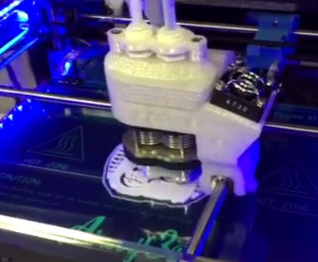The world of industrial manufacturing is going through one of the biggest changes it has seen since Henry Ford adopted the assembly line technique of optimizing production. This change has the potential to redefine the kinds of structuremarlins that manufacturers can assemble, and how production of parts is handled.
What is the cause of this change? 3D printing. Here are a few of the ways in which this remarkable new technology is changing the manufacturing industry:
Incredible Freedom in Translating Designs to Reality
 With traditional manufacturing techniques, there were always a few specific limitations on what could be made using polymers. The polymers had to either:
With traditional manufacturing techniques, there were always a few specific limitations on what could be made using polymers. The polymers had to either:
- Conform to a mold
or - Be applied as a coating to another object
With an injection mold, the polymer’s shape couldn’t be too complicated, as the liquid polymer would fill up the available space, and a complicated shape might not separate from the mold.
The coating method required some base material, such as a metal wire form, to be bent into shape first before applying the polymer. While this does provide high strength for materials handling applications, there is extra tooling, time, and material spent this way.
3D printing, or additive manufacturing, assembles objects layer by layer. Because of this, more intricate shapes can be made since parts will not have to be removed from a mold. This allows for complicated shapes to be made entirely out of a single piece of polymer without having to resort to secondary assembly techniques.
New Opportunities for Conserving Material
With 3D printing, a polymer shape can be made using only as much material as needed for the task, rather than the amount of material it would take to fill an injection mold.
Think of it like this: if you were to create an injection mold with a cavity space that had a 3” cylinder at one point, then you would need to use enough material to fill that entire cavity. With 3D printing, however, you can program the printer to only assemble the outer shell to the minimum thickness necessary to support the function of the part.
With some 3D printers having a margin of error that is less than two microns, it is easier than ever to conserve material and save money by using only what is necessary to complete the part to meet specifications.
Reductions in the Need for Welds
As 3D printing technology continues to grow in scale and the kinds of materials that can be used in the process, we may see a significant reduction in the need to weld objects.
For example, rather than having to weld multiple complicated metal forms together to from multiple lengths of shaped wire, custom forms could be assembled from a single 3D print job. Although current 3D printing machines work with polymer compounds, who knows what materials future models may be able to “print” with.
Elimination of Tooling Costs/Easier Prototyping
 Normally, when making a small production run of a product, there are lots of extra tooling costs attached. Robots have to be set up, tools have to be calibrated, and wire or sheet metal of a specific width or thickness has to be acquired, spooled, welded, cut, etc.
Normally, when making a small production run of a product, there are lots of extra tooling costs attached. Robots have to be set up, tools have to be calibrated, and wire or sheet metal of a specific width or thickness has to be acquired, spooled, welded, cut, etc.
With a 3D printer, however, there are no tooling costs beyond inserting a spool of the right material and the time it takes to program the machine for a given job. The machine handles the rest from there.
This makes it much easier to do limited production runs of a specific part without breaking your manufacturing budget. Previously, producing only one or two units typically didn’t make much sense, as the added expenses from tooling would have an enormous impact on the cost per basket. Now, you can much more easily justify the creation of an object simply to have a real-world test of a concept.
Check out the 3D printing page here for more info about Marlin Steel’s 3D printing capabilities!



.gif)


